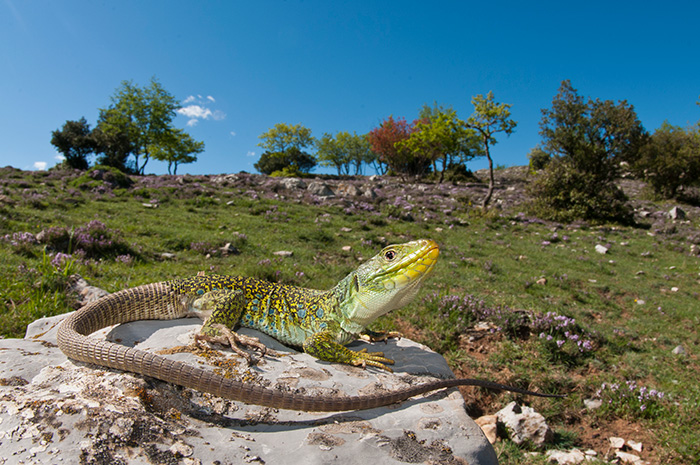
The ocellated lizard. The name fits perfectly, in fact the presence of blue circles on the hips is one of the principle characteristics of this species. And it’s not over, this lizard reach considerable size, on average about 60 cm for an adult male, for this reason it is one of the biggest lizard in Europe.
The two sexes are distinguishable for the different proportion of head to body; males, in fact, have a bigger and longer head than females, and an enlargement at the base of the tail, for the presence of the reproductive organs (hemipenis).
In the juvenile there aren’t circles like adults, but there are azure circles on the hips and green circles on the back.
Scientific name Timon lepidus, ex Lacerta lepida, in this genre belong to four species, distributed in the Mediterranean Basin and in the Middle East.
You can find the Ocellated lizard in Portugal, Spain, in some areas of French and in west Liguria (Italy), eastern boundary for this animal.
The diet is characterized by Arthropoda, mostly Coleoptera, and sometimes even other reptiles, like lizards and small snakes, and small mammals.
The typical habitat is a “dry” habitat, with many shelters like rocks, bushes, roots, stone walls and, in French, burrows of common rabbit (Oryctolagus cuniculus). Where the population of this lizard use the rabbit’s burrows, it is directly related with abundance of this mammal.
Generally there are many places, antrophized, that cannot be able to living for an ocellated lizard, for example the golf courses. In fact, these are one of the most negative factor of impact; but in one italian location happens a strange fact: one of that place is populated by this lizards. Here, the lizards are less suspicious because they are accostumed to people, that play in the adjacent fields.
Conservation
The reduction of Timon lepidus’ natural habitat caused a decrease of its distribution range, mostly in Italy.
The natural evolution of plant’s associations to woodlands is one reason, together the human impact, of decrease of its natural habitat. The species is not protected by European laws, because is fairly abundant, mainly in Portugal and Spain; in Liguria is protected by regional law 4/92 “Protection of fauna minor”.

